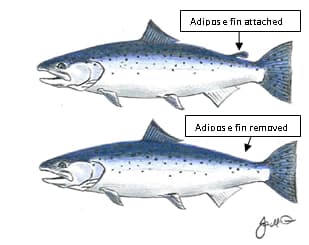Fish Tags Help Indiana Biologists Track Chinook Salmon Trends

Microscopic tags are helping Indiana biologists learn about Chinook salmon movement and life history patterns in Lake Michigan and its tributaries.
Under direction of the federally funded Great Lakes Mass Marking Program started in 2011, every Chinook salmon stocked in the Great Lakes over a five-year period will have a coded, stainless steel wire tag (CWT) identifying the stocking agency, date and location. The tags are placed in the snouts of the fish. Fish with a CWT can be recognized by their clipped missing adipose fin (see diagram below). The project will help biologists evaluate survival and growth rates of stocked fish, track movement patterns, and provide a better estimate of natural reproduction in Lake Michigan.
Indiana DNR biologists collected 105 CWT fish caught by anglers during April and May of 2012. Only 4 percent of those fish were stocked by Indiana; most fish were stocked by Wisconsin (53 percent) and Michigan (30 percent), with the remaining 12 percent of fish coming from Illinois. Surprisingly, five of the tagged Chinook came from Lake Huron. Fish stocked in May 2010 and caught in spring 2012 averaged 27 inches and 7 pounds. Fish stocked in May 2011 averaged 16 inches and 1.5 pounds.
Indiana biologists also collected 61 tagged Chinooks during sampling of Trail Creek in October 2012. The 2011-stocked fish averaged 22 inches and 3.7 pounds.
“We expected that every Chinook returning to Trail Creek would be a fish stocked by Indiana DNR,” said Brian Breidert, Indiana’s Lake Michigan fisheries biologist. “Surprisingly, that was not the case.”
Preliminary analysis shows 71 percent of the tagged fish were stocked by Indiana, 16 percent by Michigan, 8 percent by Illinois, and 5 percent by Wisconsin. As the Mass Marking Program continues, DNR biologists should learn a great deal more about where Indiana’s fish are caught, which tributaries they return to, and how well fish from different age classes and stocking sites survive.
Eventually, all trout and salmon stocked in Lake Michigan will be tagged under the guidance of the Mass Marking Program, to further enhance restoration and management efforts in Lake Michigan.

